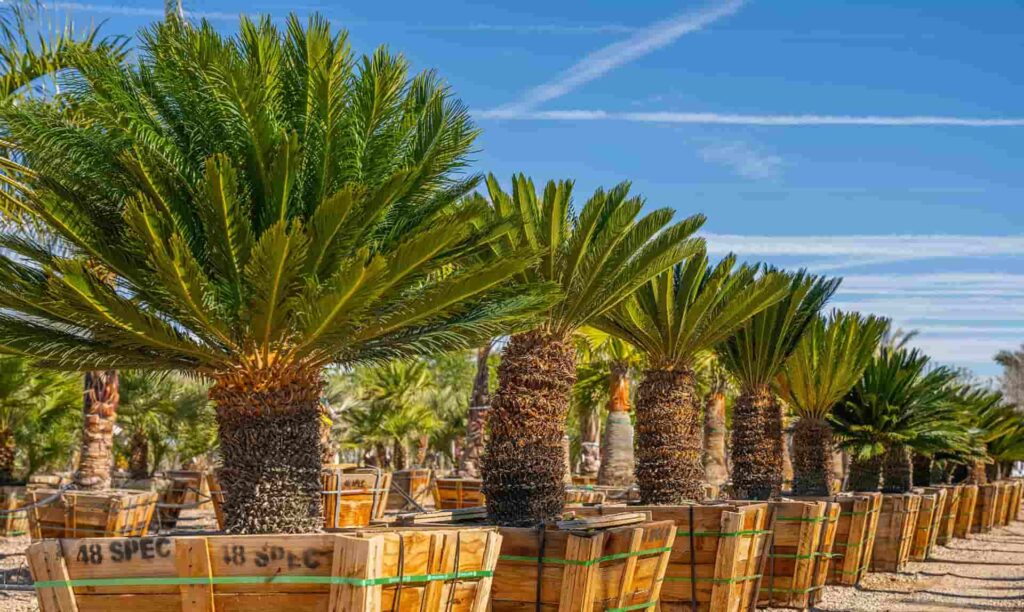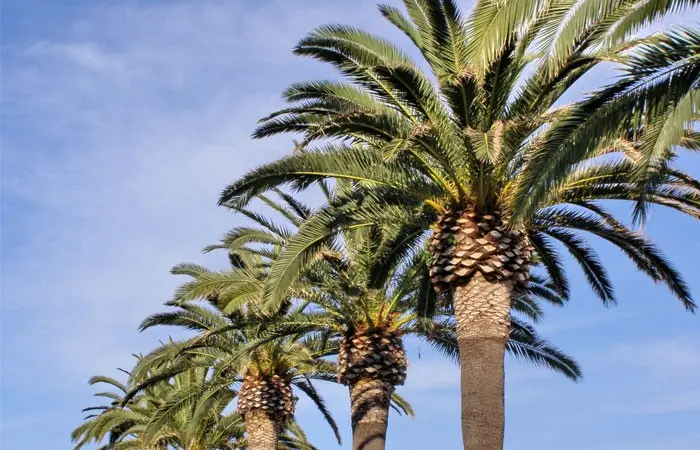Palm Trees That Look Like Pineapples – Detailed Guide!
Palm trees that look like pineapples, such as the Canary Island date palm, feature a bulbous, spiky trunk base from unique pruning styles, adding decorative tropical elegance to landscapes and gardens.
Palm trees have long been associated with tropical beauty, exotic vacations, and lush landscapes. But there’s a particular type of palm that instantly grabs attention: palm trees that look like pineapples. With their spiky, bulbous bases and elegant fronds, these trees add a unique charm to gardens and urban spaces alike.
In this article, we’ll explore why some palm trees look like pineapples, which species have this distinctive appearance, how to identify them, and how to care for them in your own landscape.
Why Some Palm Trees Look Like Pineapples
The pineapple like look in certain palm trees comes from the way their trunks are pruned and how their leaf bases form. When older fronds are trimmed at the right angle, they leave behind overlapping patterns that resemble the rough, spiky texture of a pineapple.
This design is not only eye catching but also adds a touch of artistry to tropical landscape trees, making them stand out in public gardens, resorts, and private homes.
Popular Palm Trees With Pineapple Shaped Trunks

While not every palm can be styled to resemble a pineapple, several species naturally lend themselves to this look. Here are the most common:
Canary Island Date Palm (Phoenix canariensis)
The Canary Island date palm is perhaps the most famous example of a pineapple palm tree species. Native to the Canary Islands, this majestic palm can grow up to 60 feet tall and has a thick, sturdy trunk that is perfect for creating the pineapple effect.
Key features:
- Scientific name: Phoenix canariensis
- Crown of large, arching fronds
- Can live for decades with proper care
- Often used in Mediterranean palm tree landscaping
Ornamental Date Palm
Another beautiful option is the ornamental palm tree with pineapple shape. While similar in appearance to the Canary Island date palm, these palms are often smaller, making them ideal for tropical garden plants in residential areas.
Key features:
- Decorative pineapple shaped base
- Adaptable to different climates
- Adds texture and visual interest to landscapes
Tropical Palms With Decorative Pineapple Base
Several tropical palm species can be trimmed to have the pineapple shaped trunk palm tree look, especially when young. Landscapers often shape them this way to add variety to exotic landscaping ideas.
Palm Trees That Resemble Giant Pineapples: How to Identify Them
Identifying a palm tree with spiky pineapple base is simple once you know the signs:
- A bulbous, rounded section near the base of the fronds
- Diamond shaped patterns from cut fronds
- Shorter, wider trunk near the crown
- Lush, green fronds extending outward like a pineapple top
This appearance is different from other palms, where fronds may be trimmed flush with the trunk, creating a smooth surface.
Difference Between Pineapple Palms and Other Palms
While many palm trees share similar fronds and heights, the key differences lie in:
- Trunk shaped Pineapple palms have a distinct bulge near the top, while other palms have uniform trunks.
- Pruning style Landscapers create the pineapple look by leaving part of the frond base intact.
- Aesthetic purpose Pineapple palms are often chosen for decorative rather than purely functional landscaping.
Unique Palm Tree Shapes for Landscaping
Using palm trees that resemble giant pineapples in your landscape design offers several advantages:
- Visual focal point They immediately draw attention and add elegance.
- Themed design Perfect for tropical resorts, coastal homes, and Mediterranean palm tree gardens.
- Adaptability Can be used as standalone statement trees or in rows along pathways.
For exotic landscaping ideas, pairing them with colorful tropical flowers or drought tolerant palm species creates a balanced and low maintenance garden.
Palm Tree Care for Pineapple Shaped Varieties

To keep your pineapple looking palm tree varieties healthy and beautiful, follow these tips:
- Proper Pruning: Pruning is key to maintaining the pineapple look. Always cut fronds at a downward angle, leaving enough of the leaf base to create the spiky texture. Over pruning can damage the tree.
- Watering: While palms are drought tolerant, younger trees need regular watering until established. For strong root growth, use deep watering.
- Fertilization: Apply a balanced, slow release fertilizer in the growing season to maintain lush, green fronds.
- Pest Control: Watch for pests such as palm weevils and scale insects, which can damage fronds and weaken the tree.
Pruning Palm Trees for Pineapple Look
To achieve or maintain the date palm with pineapple look, professional landscapers recommend:
- Removing only dead or dying fronds
- Shaping the upper trunk to create the rounded base
- Avoiding cuts too close to the crown, as this can stunt growth
With the right care, your palm tree with a spiky pineapple base can be the crown jewel of your landscape for decades.
FAQs:
1. What type of palm tree looks like a pineapple?
The most common is the Canary Island date palm (Phoenix canariensis). Its trunk can be pruned to create a pineapple like base, making it a popular choice for tropical and Mediterranean style landscapes.
2. How do palm trees get the pineapple shaped trunk?
The pineapple shaped look comes from selective pruning. Landscapers cut old fronds at specific angles, leaving a patterned, bulbous base that resembles the texture and shape of a pineapple.
3. Can any palm tree be shaped like a pineapple?
Not all palms can achieve this look. Larger species like the Canary Island date palm and certain ornamental date palms naturally lend themselves to the pineapple shaped trunk style through pruning.
4. Are pineapple looking palm trees high maintenance?
They require moderate maintenance, including regular pruning to maintain shape, seasonal fertilization, and occasional pest checks. Once established, many species are drought tolerant and thrive in warm, sunny environments with minimal watering.
5. Do pineapple shaped palm trees grow in cold climates?
Most pineapple style palms prefer warm climates, but some can tolerate mild frost. In colder regions, they may require winter protection or container planting for easy relocation during freezing temperatures.
Conclusion:
Palm trees with pineapple shaped trunks bring a unique and artistic touch to landscapes, blending tropical charm with ornamental beauty. Species like the Canary Island date palm stand out with their distinctive crown and textured trunk base, making them ideal for decorative gardens, resorts, and urban spaces. With proper pruning, watering, and seasonal care, these palms can thrive for decades, becoming the focal point of any outdoor setting. Whether for Mediterranean elegance or tropical flair, they remain a stunning choice for creative landscaping.






